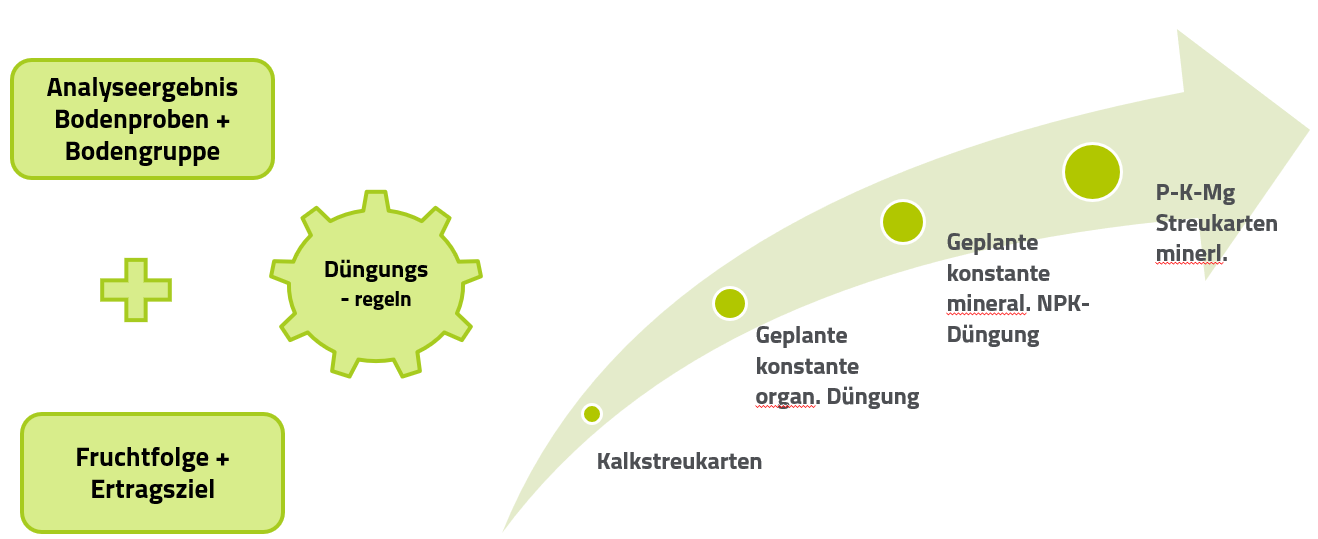2. Düngeplanung und Streuauftrag erstellen
Handlungsempfehlung für die Fruchtfolgedüngeplanung
Bei der Düngeplanung im agriPORT sollten Sie genau so vorgehen, wie es auch aus pflanzenbaulicher Sicht sinnvoll ist:
- Kalk (Streukarte)
Bringen Sie Ihren Kalkhaushalt in Ordnung! Gehen Sie hier bspw. nach Fruchtarten vor und/oder nach den Schlägen mit dem höchsten bzw. geringsten Kalk-Bedarf. Sie können nach 100% des Bedarfs planen oder - bei großen Kalkmengen - die Planung auf mehrere Jahre aufteilen. Lesen Sie hierzu auch die fachlichen Informationen im Bereich pH-Wert und Kalkung. - Organik (Konstant)
Verplanen Sie die Ihnen zur Verfügung stehende Organik zu den entsprechenden Kulturen im Herbst sowie im Frühjahr! Die Ausbringung findet i.d.R. konstant statt, daher sollte die Nährstofflieferung aus der Organik der Grundstein für weitere Planungen sein. - Mehrnährstoffdünger (NPK) (Konstant)
Planen Sie fixe Maßnahmen zu bestimmten Kulturen, z.B. eine Unterfußdüngung mit DAP im Mais. Ebenso sollten Sie Ihre Stickstoffdünger mit P- und K-Anteilen in die Planung einbeziehen. Planen Sie die NPK-Düngergaben konstant. - Fruchtfolgedüngeplanung
Führen Sie diese Schritte für den gesamten Planungszeitraum zu den jeweiligen Kulturen in der gesamten geplanten Fruchtfolge durch. So werden auch die Organik- und die fixen Maßnahmen der Folgejahre auf den Fruchtfolgebedarf angerechnet. P, K, Mg Streukarten
Schauen Sie sich jetzt die Schläge am besten nach Fruchtart sortiert, an. So sehen Sie gewisse "Mangel-Muster" am besten und können mit gezielten Düngern die Nährstofflücken schließen, möglicherweise auch erst in den Folgejahren.
weitere Hilfestellungen zur Düngeplanung und zum Streukartenexport erhalten Sie in der Hilfefunktion direkt in agriPORT.
Videos on the application of the fertilizer planning and order management modules
5 steps for optimal basic nutrient supply | Make optimal use of nutrients from organic fertilization |
The following film shows how you can manage your basic nutrient supply in 5 steps by using the "Fertilizer Planning" module and 1. View the nutrient situation 2. Choose fields for fertilization 3. Create planning 4. Export scatter cards 5. Book output | If organic fertilizers play a key role in your business, watch this video. We will show you how you can use agriPORT to calculate the nutrients in the organics so that you can get the most out of them. |
Further help for fertilizer planning is available here: agriPORT help area - fertilizer planning
Further help on order management is available here: agriPORT help area - order basic fertilization
Recommended action for fertilizer planning
When planning fertilizers in agriPORT, you should proceed exactly as it makes sense from a plant engineering perspective:
- Plan the organics available to you for the appropriate crops in autumn and spring! The application usually takes placeconstant instead, so the nutrient supply from the organic should be the cornerstone for further planning. You can book the measures directly so that the nutrients applied with the organic matter are already deducted from the remaining requirements.
- Tidy up your lime household! Go here, for example, for fruit types before and / or after the beats with the highest or lowest lime requirement. You can plan according to 100% of the demand or - for large amounts of lime - split the planning over several years. Please also read the technical information in the area pH-Wert und Kalkung.
- Plan fixed measures for certain cultures, e.g. underfoot fertilization with DAP in maize. You should also include your nitrogen fertilizers with P and K components (Compound fertilizer)in the planning (according to map or constant).
- Carry out these steps for the entire planning period for the respective crops in the entire planned crop rotation. The organic and fixed measures of the following years are also counted towards the total nutrient requirement.
- Now look at the blows, best sorted by fruit type. This is the best way to see certain "deficiency patterns" and to use targeted fertilizers to close the nutrient gaps, possibly also in the following years.
